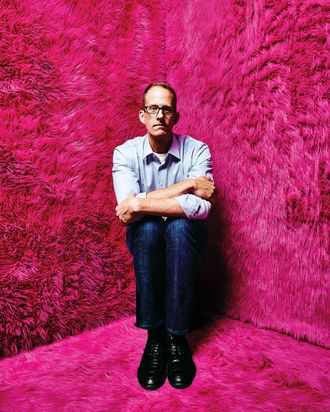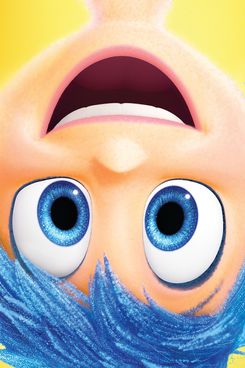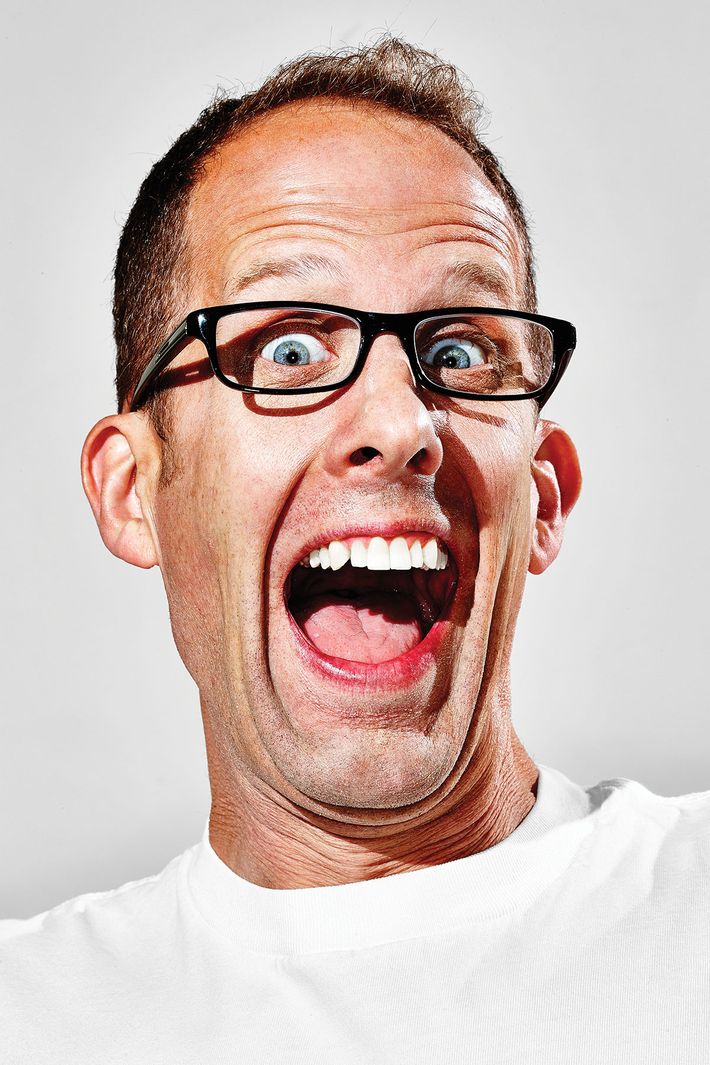
Pete Docter, the third animator hired by Pixar, looks, improbably, a whole lot like the cartoon characters he helps to create. His body seems stretchable, bendable, as long of limb and narrow of face as the cowboy Woody in Toy Story; his eyebrows seem as motile as those of Russell, the 8-year-old Wilderness Explorer in Up. Docter is 46, but his affect is that of an overgrown boy, a goofball who buys a cotton-candy machine for himself because — heck, just because. On a recent trip to the macaron palace Ladurée in Soho, as we wait behind velvet ropes to select our pastel cookies, Docter bends down from his considerable height to recommend the rose-petal variety even though, he whispers conspiratorially, certain connoisseurs might disagree. The flavor has been described to him as “just like your grandmother’s bathroom,” he says, so perhaps it’s an acquired taste.
The next day, he’s in the mostly empty lobby of a downtown cineplex where Pixar’s new movie, Inside Out, which he co-wrote and directed, has just been screened. The crowd has dispersed, and Docter is using this brief liberty to pose cartoonishly in front of a humongous penny-candy machine. His eyes bug out with exaggerated joy. His smile is a rictus of glee, his hands clasped before him in a rigid posture of delight. He may as well be Olive Oyl glimpsing Popeye, her beloved: You can almost see the pulsing hearts encircling his head. It’s a setup shot, a Docter-esque joke — a sight gag wrapped in a pun wrapped in a love letter. The machine, with its row of tubes stuffed with candy baubles, is called “Sweet Amanda’s” and seems to have been conjured in an animator’s imagination. Docter loves sweets. Docter loves his wife. His wife is named Amanda. Get it? From near the machine, Docter directs the Pixar publicist to take the picture. She does, and the photo is ready to travel through the ether to Oakland, where the Docters and their two teenagers live.
That Docter, this clownish scribbler, this renderer of talking toys and conscientious robots and houses that float away on helium balloons, might become a generation’s Dante, creating for the masses a “family entertainment” that goes straight to the heart of human despair, may seem at first like a ludicrous claim. But with Inside Out, he has done just that. Shakespeare’s fools were his prophets, and in the 21st century comedians are our sages. Hints of Docter’s darker side were evident in Up, for which he won an Academy Award in 2010: What cartoonist makes a lovable heroine infertile and then kills her in a film’s first 15 minutes? In Inside Out, Docter goes even deeper, taking on the subject of human consciousness itself and, like a child diving for a ring in the ocean, emerges from its murky depths with a Technicolor poem on childhood’s end and the importance of being sad.
The idea, he tells me over iced tea in a hotel bar, was to make a movie about what goes on inside the mind of an 11-year-old girl. His inspiration was his own daughter, Elie, who had been an outgoing and voluble child, the model (and the voice) for the supremely confident snaggletoothed adventuress in Up. But when Elie turned 11, everything changed. “The kid in Up was a lot like my daughter at the time — full of energy and goofiness, and then, yeah. Eleven.” The transformation wasn’t instantaneous, he remembers. “But it was pretty quick — like, Oh, she’s really different now.” Elie grew quiet, self-conscious, and moody, interpreting every stray eye roll as a personal affront. Elie is a good student, Docter says, but “there were a couple moments where she’d collapse on the floor, overwhelmed, saying, ‘Tomorrow I have to do this test and I’m not ready, waallla waaaaa.’ ”
It’s a threshold age, the doorway to adolescence, and many children (especially girls) at 11 are mature enough to regard their imminent future with an entirely reasonable mixture of excitement and dread. “They’re still children, and they want to be there,” says Docter. “But they see adulthood and they want to be there. So they’re completely in this weird, teetery space.” Docter remembers that at around 11 years old, Elie “dragged a piece of plywood up to her room and did some tap dancing on it even though she had no idea how to tap-dance. Still, that was a possibility in her mind.” An 11-year-old girl — and I have one at home — may be playing with American Girl dolls one moment and liquid eyeliner the next; in the evening, after dinner, she may beg for cuddles or slam the door. Even the most even-tempered parents describe the phase as unmooring. When Elie was 11, Docter would arrive at work in the morning and vent. I wonder, he’d say, what’s happening in her head.

Inside Out is an attempt to explore this “teetery space,” an unusual effort for any major film studio, much less one that happens to be owned by a company as invested in happy endings as Disney, the parent company of Pixar. The narrative travels along two parallel tracks. There’s the story of Riley, who at 11 moves away from her happy childhood home in Minnesota to San Francisco (construed in drabs and grays), where her father is launching a start-up. And there’s the story of Riley’s emotions, five brightly colored abstracted humanoids — Joy, Sadness, Anger, Fear, and Disgust — who from their headquarters in Riley’s mind have to steer her like air-traffic controllers through this unexpected and unpredictable turbulence after 11 years of smooth sailing. About a year ago, Docter tells me, Pixar screened the movie for a bunch of kids, to test the concern some executives had “that there was too much complexity and that maybe little kids would be confused by it. The good news was that they totally got it.” Docter’s daughter is 16 now. “I’m not sure how much she sees of her own life in the film. She has admitted that she teared up.”
(In my house, the movie has given us a new way to talk about how we feel. “Who’s driving now?” I ask my daughter as we’re riding bikes through the city streets of Brooklyn. “Joy,” she answers, “and a little bit of Fear.” “Who’s driving when you’re at work?” she asks me later. “Joy,” I answer, “and a little bit of Fear.”)
All her life, Riley has been a happy kid, and Joy — a bright, tense sprite, voiced by Amy Poehler — has been running the show. Optimistic, determined, and annoying, Joy is a cross between Tinker Bell and a Tiger Mom. Like every parent in the world — like me, I realized as I sat shoulder to shoulder with my daughter in the dark — she wants her child to be happy no matter what, and at the outset of the movie you see her crowing over Riley’s accrual of happy memories (depicted in the movie as golden orbs aligned along shelves), like an obnoxious parent oversharing sunny vacation pics on Facebook. When Riley’s mood begins to falter — she misses Minnesota and her friends; there are mean girls at her new school; her parents are distracted by their own problems — Joy digs in. Shoving the other emotions, especially Sadness, aside, she sees Riley’s problems as hers to solve. There’s a control freak’s desperation to her optimism so familiar that I felt found out. How many times have I planned a trip or cooked a meal with an eye toward stocking my own child’s memory banks with a retrospective happiness I hope she’ll save for later?
Docter, who started work at Pixar 25 years ago, the day after he graduated from college, says that, of all the emotions, he relates to Joy the most. Joy was the hardest character to write, he says, because she had to embody such a broad spectrum of happy feelings, from exuberance to relief, and because to remain sympathetic she had to walk a thin line between saccharine and overbearing. “When we were struggling to find Joy, one of our writers said, ‘Joy is you, Pete.’ ”
As Riley’s pain coalesces, an unfortunate accident occurs and Joy and Sadness get ejected from headquarters and lost in the nether regions of the mind. And so, with Disgust, Fear, and Anger in charge, Riley begins to rebel. She yells at her parents; she sulks; she fights with her friend; she allows herself to imagine — and do — things that the former Riley would not have considered. It’s every parent’s nightmare, but, as Docter deftly shows, it’s every parent’s truth as well, for no amount of effortful trying will ever spare one’s beloved child from future hurt, nor from the changes that hurt will bring. All that parental hope and industry — all that Joy — can turn on a dime and feel in an instant like impotence, and you can find yourself, as I do sometimes, counting to ten, or 20, or murmuring a mantra you once heard: “ ‘Like a rock in a stream, a rock in a stream.’ ” As Joy and Sadness wander the maze of Long Term Memory, which evokes an Amazon fulfillment center, seeking a route back to headquarters, the light in Riley’s eyes goes out. “As a parent,” Docter says to me, “that’s what breaks your heart about your kid changing.”
There are people who have creepily fetishized childhood, the Michael Jacksons of the world who wish to live in a childhood they never had. But Docter is too well adjusted for that. Like Riley, he grew up in Minnesota, ground zero for American normalcy, where he was the oldest of three, attended a massive suburban high school, and had the distinction of being uniquely bad at sports in a place where, and an era when, being bad at sports tagged you as a hopeless geek. During a question-and-answer session after the Inside Out screening, Docter confessed that middle school was difficult for him. “For some reason, I sympathized with girls more than boys. The social stuff really stressed me out,” he says, “and it still does.” But Docter knows that while he’s lucky to work at a company and in an industry that allows him to behave like a boy, he is, in fact, a man. “Having kids is like forcing you to be less selfish,” he said in an interview in 2009, “because you care so much about these other guys and you start to put their interests first.”

The movie begins to tilt toward its emotional center about a third of the way through. In Long Term Memory, Joy and Sadness meet Bing Bong, Riley’s imaginary friend from when she was about 3 years old. Bing Bong and Riley had been constant companions, careening around the living room and pretending to fly in an old red wagon dressed up as a rocket. Bing Bong is Muppet-ish in his fuzzy floppiness; made out of cotton candy, he’s part elephant and part cat, and he speaks fluent dolphin. He watches, despairing, as Mind Workers heave the red wagon down into a subterranean dump, a place from which memories never return. He knows what it means — that Riley has grown out of him. (It is, in some way, as if Puff the Magic Dragon were able to talk and tell his side of the story.) Joy, ever the cheerleader, tries to lift him out of his funk. If he’ll just come with them to headquarters, she’ll help him reignite his friendship with Riley, she insists. She’ll make Riley see his relevance. But Bing Bong won’t be consoled. And then Sadness, who is voiced by Phyllis Smith of The Office, and who has until now been sighing and whining like a fat, female Eeyore, sidles over to him and sits. She sees that Bing Bong is mourning the end of something. She notices he’s sad. And Bing Bong stops crying.
Elie didn’t have an imaginary friend when she was small, Docter tells me, but he did. His name was Norman, and he was “a small elephant that drove a little car. I would imagine him driving up and around. It was a way of filling the time. I knew it was not real, but it was still fun to just imagine.” After Sadness consoles Bing Bong, the power begins to shift toward her, for it is Sadness who has the gumption to call out the fantasy for what it is. It’s a terrible truth, so terrible that none of the usual purveyors of childhood myths — not Disney, not the Grimms, not Lewis Carroll or C. S. Lewis or Tolkien or Dahl — dare to tell it out loud. Imaginary friendships aren’t sustainable in an adult life. Leaving childhood behind is sad.
It may help to know that Docter is a believing Christian and regularly attends First Presbyterian Church in Berkeley. But his is not, he assures me, the judgmental or lecturing kind of faith. Too often, he says, Christians find support for their opinions in the Bible, but then when you actually read the verse yourself, “it’s confusing!” In faith, as in life, Docter is drawn to stories and people full of doubt and complexities. Sitting cross-legged now on a divan in the hotel bar, well into his second iced tea, he gives an example. About three years into the making of Inside Out, he realized the movie wasn’t working. He knew he had a cool idea, but the film’s fulcrum — a sense of its own meaning — had not yet become clear. He was walking around Oakland, “rubbing his temples,” feeling like a failure and a fraud. He imagined a future without Pixar and its salary and perks; he imagined having to sell his house. And in that imaginary future catastrophe, he knew he’d be okay.
“I could do without my house,” he says, “and Pixar’s a great company, but it’s really the people that are the most important thing. And the emotions are the key to that. The people I feel closest to are people who, yeah, I’ve had good times with, but we’ve also suffered through loss together. I’ve been pissed at them. I’ve been disgusted by them. So, this very subject that we’re making this movie about is the key to the most important thing in our lives, which is relationship.” What Docter loves about Christianity, he tells me, is that “it offers a relationship.”
In the end, Joy sees the importance of Sadness, her ability to deepen and enrich life’s experiences in a way she cannot; like a hypervigilant parent guarding against any possible failure, she understands that she has only one choice: to let the other emotions drive sometimes. Joy isn’t overthrown; she steps aside of her own accord, the single gesture in the movie that pushes me to tears when I consider it in my own case. You know in your head that your kid has to suffer — that her suffering is hers, not yours, and that she has to find her own way through it. But allowing her to do it is another thing entirely, and the very prospect induces vertigo. In letting go, a parent concedes that unhappy endings are possible, even for the most cherished children. When Riley confesses to her parents her despair, it’s an echo of the Bing Bong scene; with Sadness in charge, she is able to be comforted. For a moment, in her parents’ arms, she becomes a little girl again.
The lesson of Inside Out is that you can’t have Joy without Sadness. You can’t have love without loss or change without pain. No one ever grows up without leaving childhood behind. Eleven-year-olds intuit this somehow, a good enough reason to act unhinged. “The gray area,” Docter tells me as he finishes the last of his tea. “It’s the interesting part.”
*This article appears in the June 15, 2015 issue of New York Magazine.


